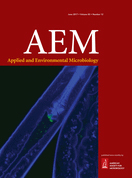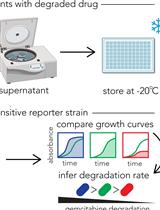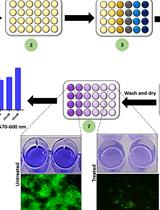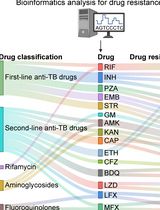- EN - English
- CN - 中文
Bacterial Aggregation Assay in the Presence of Cyclic Lipopeptides
环脂肽存在情况下细菌聚集实验
(*contributed equally to this work) 发布: 2018年01月05日第8卷第1期 DOI: 10.21769/BioProtoc.2686 浏览次数: 9417
评审: Valentine V TrotterJose Antonio Reyes-DariasAnonymous reviewer(s)
Abstract
Lipopeptides is an important class of biosurfactants having antimicrobial and anti-adhesive activity against pathogenic bacteria. These include surfactin, fengycin, iturin, bacillomycin, mycosubtilin, lichenysin, and pumilacidin (Arima et al., 1968; Naruse et al., 1990; Yakimov et al., 1995; Steller and Vater, 2000; Roongsawang et al., 2002; Vater et al., 2002). To date, none of these lipopeptides have been reported to possess any anti-motility activity. We isolated, purified and characterized two novel cyclic lipopeptides (CLPs) from Bacillus sp. 176 using high performance liquid chromatography, mass spectrometry and nuclear magnetic resonance spectroscopy. CLPs dramatically suppress the motility of pathogenic bacterium Vibrio alginolyticus 178, and promote cellular aggregation without inducing cell death. Cell aggregation assay was performed with the modification according to methods described by Dalili for anti-biofilm assay (Dalili et al., 2015). In future, this assay can be adapted to test both the cell aggregation and anti-biofilm activity of lipopeptide-like active substances derived from bacteria.
Keywords: Cyclic lipopeptides (环脂肽)Background
Overuse of broad-spectrum antibiotics and the accompanying proliferation of drug-resistant bacteria have stimulated efforts to develop environment-friendly biocontrol measures to reduce health hazards and environmental pollution (Nam et al., 2016; Sajitha et al., 2016). In recent years, the anti-microbial properties of biological surfactants have been increasingly recognized and harnessed for antibacterial, antifungal, and antiviral applications (Cameotra and Makkar, 2004; Singh and Cameotra, 2004; Rodrigues et al., 2006). Lipopeptides are the most widely reported class of biosurfactants having antimicrobial and 100 anti-adhesive activity against pathogenic bacteria, due to the amphipathic nature of their peptide and fatty acid components (Das et al., 2008; Dalili et al., 2015). In this study, two cyclic lipopeptides (CLPs) derived from a competing bacterium (Bacillus sp. 176) are found to inhibit the motility and promote the aggregation of V. alginolyticus 178. We purified and characterized the active anti-motility compounds and determined their structural and functional properties. In order to explore the mechanism of action of the CLPs, their impact on cell aggregation, adherence, and the expression of flagellar assembly components in V. alginolyticus were also investigated.
Materials and Reagents
- Pipette tips (Corning, Axygen®, catalog numbers: T-200-Y-STK , T-300-L-R , T-1000-B )
- 15 ml culture tube (Bomei, catalog number: SGJS15ML )
- Flat bottom 96-well microtiter plate (Corning, catalog number: 3628 )
- Coverslips (CITOTEST LABWARE MANUFACTURING, catalog number: 80340-1130 )
- Bacterial strains (Identified and stored in our lab)
- V. alginolyticus 178
- V. anguillarum
- V. splendidus
- V. vulnificus
- Pseudomonas aeruginosa
- P. stutzeri
- Staphylococcus aureus
- Bacillus sp. 176
- B. subtilis
- V. alginolyticus 178
- Methanol (Sinopharm Chemical Reagent, catalog number: 10014108 )
- Ethanol (Sinopharm Chemical Reagent, catalog number: 10009259 )
- Peptone (Solarbio, catalog number: P8450 )
- Tryptone (OXOID, catalog number: LP0042 )
- Yeast extract (OXOID, catalog number: LP0021 )
- Agar powder (Solarbio, catalog number: A8190 )
- Sodium chloride (NaCl) (Sinopharm Chemical Reagent, catalog number: 10019318 )
- Crystal violet (Sinopharm Chemical Reagent, catalog number: 71012314 )
- Glacial acetic acid (Sinopharm Chemical Reagent, catalog number: 10000218 )
- Gelatin (Solarbio, catalog number: G8060 )
- 25% glutaraldehyde solution (Sinopharm Chemical Reagent, catalog number: 30092436 )
- Dimethyl sulfoxide (DMSO) (MP Biomedicals, catalog number: 02196055 )
- Saline LB broth (see Recipes)
- LB broth (see Recipes)
- 1% (w/v) solution of crystal violet (see Recipes)
- 30% (v/v) acetic acid (see Recipes)
- Modified 2216E broth (see Recipes)
- 1% (w/v) gelatin solution (see Recipes)
- 5% glutaraldehyde solution (see Recipes)
- Sterile saline solution (see Recipes)
- 10 mg/ml CLPs (see Recipes)
Equipment
- 1-10 μl pipettor (Gilson, model: P10N )
- 20-200 μl pipettor (Gilson, model: P200N )
- 100-1,000 μl pipettor (Gilson, model: P1000N )
- Autoclave sterilizer (Zealway Instrument, model: GI80TW )
- Constant temperature shaker (CRYSTAL, model: IS-RDS3 )
- Centrifuge (Eppendorf, model: 5418 R )
- SYNERGY-H1 microplate reader (BioTek Instruments, model: Synergy H1 )
- Scanning electron microscope (SEM) (Hitachi, model: S-3400N )
- Transmission electron microscope (TEM) (Hitachi, model: H-7650 )
- Biological safety cabinet (Heal Force, model: HFsafe 900LC )
Procedure
文章信息
版权信息
© 2018 The Authors; exclusive licensee Bio-protocol LLC.
如何引用
Xiu, P., Liu, R., Zhang, D. and Sun, C. (2018). Bacterial Aggregation Assay in the Presence of Cyclic Lipopeptides. Bio-protocol 8(1): e2686. DOI: 10.21769/BioProtoc.2686.
分类
微生物学 > 抗微生物试验 > 抗细菌试验
微生物学 > 微生物生物膜 > 生物膜培养
细胞生物学 > 细胞运动 > 细胞运动性
您对这篇实验方法有问题吗?
在此处发布您的问题,我们将邀请本文作者来回答。同时,我们会将您的问题发布到Bio-protocol Exchange,以便寻求社区成员的帮助。
提问指南
+ 问题描述
写下详细的问题描述,包括所有有助于他人回答您问题的信息(例如实验过程、条件和相关图像等)。
Share
Bluesky
X
Copy link












